2016 CHEVROLET CITY EXPRESS CARGO VAN ECU
[x] Cancel search: ECUPage 82 of 297

Black plate (43,1)Chevrolet City Express Owner Manual (GMNA-Localizing-U.S./Canada-
7707496) - 2015 - CRC - 11/26/14
Seats and Restraints 3-43
Warning (Continued)
SeePassenger Sensing System
on page 3-22 for additional
information.
Rear-facing child restraints should
not be installed in the vehicle, even
if the airbag is off.
If a child restraint uses a top tether,
see Lower Anchors and Tethers for
Children (LATCH System) on
page 3-38 for top tether anchor
locations.
Do not secure a child seat in a
position without a top tether anchor
if a national or local law requires
that the top tether be anchored, or if
the instructions that come with the
child restraint say that the top strap
must be anchored.
In Canada, the law requires that
forward-facing child restraints have
a top tether, and that the tether be
attached. Securing a Forward-Facing Child
Restraint
When using the lap-shoulder belt to
secure a forward-facing child
restraint in this position, follow the
instructions that came with the child
restraint and the following
instructions:
1. Move the seat as far back as it
will go before securing the
forward-facing child restraint.
When the passenger sensing
system has turned off the front
outboard passenger frontal
airbag, the off indicator on the
passenger airbag status
indicator should light and stay lit
when you start the vehicle
unless the passenger seat is
unoccupied. See Passenger
Airbag Status Indicator on
page 5-10.
2. Put the child restraint on the seat. 3. Pick up the latch plate, and run
the lap and shoulder portions of
the vehicle’ s safety belt through
or around the restraint. The child
restraint instructions will show
you how.
4. Push the latch plate into the buckle until it clicks.
Position the release button on
the buckle so that the safety belt
could be quickly unbuckled if
necessary.
Page 83 of 297
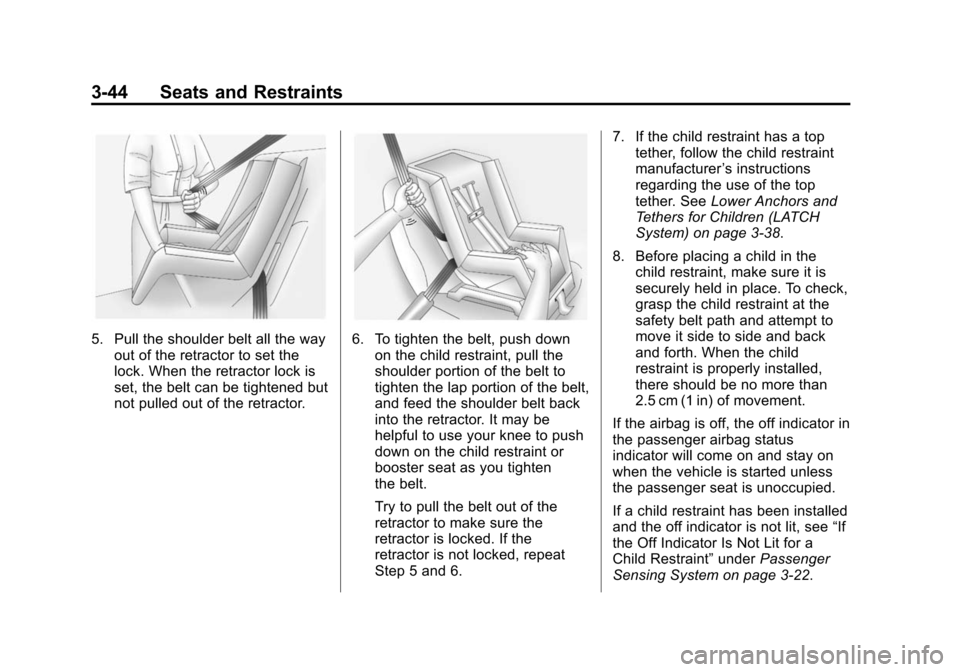
Black plate (44,1)Chevrolet City Express Owner Manual (GMNA-Localizing-U.S./Canada-
7707496) - 2015 - CRC - 11/26/14
3-44 Seats and Restraints
5. Pull the shoulder belt all the wayout of the retractor to set the
lock. When the retractor lock is
set, the belt can be tightened but
not pulled out of the retractor.6. To tighten the belt, push downon the child restraint, pull the
shoulder portion of the belt to
tighten the lap portion of the belt,
and feed the shoulder belt back
into the retractor. It may be
helpful to use your knee to push
down on the child restraint or
booster seat as you tighten
the belt.
Try to pull the belt out of the
retractor to make sure the
retractor is locked. If the
retractor is not locked, repeat
Step 5 and 6. 7. If the child restraint has a top
tether, follow the child restraint
manufacturer ’s instructions
regarding the use of the top
tether. See Lower Anchors and
Tethers for Children (LATCH
System) on page 3-38.
8. Before placing a child in the child restraint, make sure it is
securely held in place. To check,
grasp the child restraint at the
safety belt path and attempt to
move it side to side and back
and forth. When the child
restraint is properly installed,
there should be no more than
2.5 cm (1 in) of movement.
If the airbag is off, the off indicator in
the passenger airbag status
indicator will come on and stay on
when the vehicle is started unless
the passenger seat is unoccupied.
If a child restraint has been installed
and the off indicator is not lit, see “If
the Off Indicator Is Not Lit for a
Child Restraint” underPassenger
Sensing System on page 3-22.
Page 84 of 297

Black plate (45,1)Chevrolet City Express Owner Manual (GMNA-Localizing-U.S./Canada-
7707496) - 2015 - CRC - 11/26/14
Seats and Restraints 3-45
To remove the child restraint,
unbuckle the vehicle safety belt and
let it return to the stowed position.
Securing a Booster Seat
{Warning
Do not use the child restraint
locking feature when using a
booster seat with the safety belts.
Follow these steps to install a
booster seat in the front
passenger seat:
1. If you must install a booster seat in the front seat, move the seat
to the rear-most position.
2. Position the booster seat on the seat. Only place it in a
front-facing direction. Always
follow the booster seat
manufacturer ’s instructions. 3. The booster seat should be
positioned on the vehicle seat so
that it is stable.
If necessary, adjust or remove
the head restraint to obtain the
correct booster seat fit. If the
head restraint is removed, store
it in a secure place. Be sure to
reinstall the head restraint when
the booster seat is removed. For
more information, see Head
Restraints on page 3-2 for head
restraint adjustment, removal,
and installation information.
If the seating position does not
have an adjustable head
restraint and it is interfering with
the proper booster seat fit, try a
different booster seat.
4. Position the lap portion of the safety belt low and snug on the
child’s hips. Be sure to follow the
booster seat manufacturer ’s
instructions for adjusting the
safety belt routing. 5. Pull the shoulder belt portion of
the safety belt toward the
retractor to take up the extra
slack. Be sure the shoulder belt
is positioned across the top,
middle portion of the child’s
shoulder. Be sure to follow the
booster seat manufacturer ’s
instructions for adjusting the
safety belt routing.
6. Follow the warnings, cautions, and instructions for properly
fastening a safety belt. See
Lap-Shoulder Belt on page 3-10.
Page 87 of 297
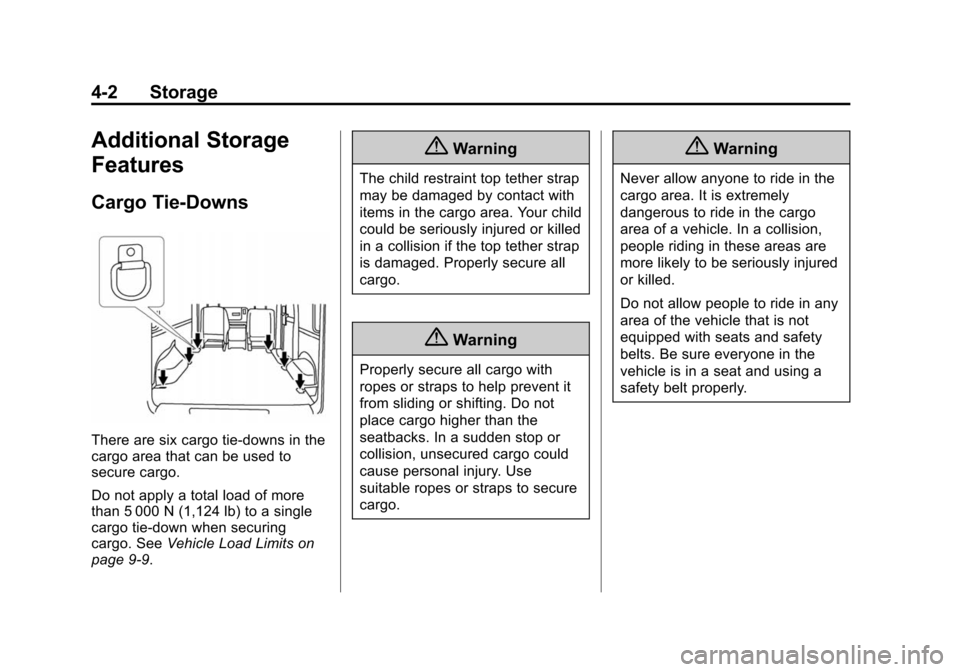
Black plate (2,1)Chevrolet City Express Owner Manual (GMNA-Localizing-U.S./Canada-
7707496) - 2015 - CRC - 11/26/14
4-2 Storage
Additional Storage
Features
Cargo Tie-Downs
There are six cargo tie-downs in the
cargo area that can be used to
secure cargo.
Do not apply a total load of more
than 5 000 N (1,124 lb) to a single
cargo tie-down when securing
cargo. SeeVehicle Load Limits on
page 9-9.
{Warning
The child restraint top tether strap
may be damaged by contact with
items in the cargo area. Your child
could be seriously injured or killed
in a collision if the top tether strap
is damaged. Properly secure all
cargo.
{Warning
Properly secure all cargo with
ropes or straps to help prevent it
from sliding or shifting. Do not
place cargo higher than the
seatbacks. In a sudden stop or
collision, unsecured cargo could
cause personal injury. Use
suitable ropes or straps to secure
cargo.
{Warning
Never allow anyone to ride in the
cargo area. It is extremely
dangerous to ride in the cargo
area of a vehicle. In a collision,
people riding in these areas are
more likely to be seriously injured
or killed.
Do not allow people to ride in any
area of the vehicle that is not
equipped with seats and safety
belts. Be sure everyone in the
vehicle is in a seat and using a
safety belt properly.
Page 88 of 297

Black plate (1,1)Chevrolet City Express Owner Manual (GMNA-Localizing-U.S./Canada-
7707496) - 2015 - CRC - 11/26/14
Instruments and Controls 5-1
Instruments and
Controls
Controls
Steering Wheel Controls . . . . . . 5-2
Horn . . . . . . . . . . . . . . . . . . . . . . . . . . 5-2
Windshield Wiper/Washer . . . . . 5-2
Clock . . . . . . . . . . . . . . . . . . . . . . . . . 5-3
Power Outlets . . . . . . . . . . . . . . . . . 5-4
Cigarette Lighter . . . . . . . . . . . . . . 5-5
Ashtrays . . . . . . . . . . . . . . . . . . . . . . 5-5
Warning Lights, Gauges, and
Indicators
Warning Lights, Gauges, andIndicators . . . . . . . . . . . . . . . . . . . . 5-6
Instrument Cluster . . . . . . . . . . . . 5-7
Speedometer . . . . . . . . . . . . . . . . . 5-8
Odometer . . . . . . . . . . . . . . . . . . . . . 5-8
Trip Odometer . . . . . . . . . . . . . . . . . 5-8 Tachometer . . . . . . . . . . . . . . . . . . . 5-8
Fuel Gauge . . . . . . . . . . . . . . . . . . . 5-8
Safety Belt Reminders . . . . . . . . 5-9
Airbag Readiness Light . . . . . . . 5-9
Passenger Airbag Status
Indicator . . . . . . . . . . . . . . . . . . . . 5-10
Charging System Light . . . . . . . 5-11
Malfunction Indicator Lamp . . . . . . . . . . . . . 5-11
Brake System Warning Light . . . . . . . . . . . . . . . . . . . . . . . 5-14
Antilock Brake System (ABS) Warning Light . . . . . . . . . . . . . . 5-15
Overdrive Off Light . . . . . . . . . . 5-15
Power Steering Warning Light . . . . . . . . . . . . . . . . . . . . . . . 5-15
Traction Control System (TCS)/Electronic Stability
Control Light . . . . . . . . . . . . . . . 5-16
Electronic Stability Control (ESC) Off Light . . . . . . . . . . . . . 5-16 Engine Coolant Temperature
Warning Light . . . . . . . . . . . . . . 5-17
Tire Pressure Light . . . . . . . . . . 5-17
Engine Oil Pressure Light . . . . 5-18
Low Fuel Warning Light . . . . . . 5-18
Security Light . . . . . . . . . . . . . . . . 5-19
High-Beam On Light . . . . . . . . . 5-19
Low Washer Fluid Warning Light . . . . . . . . . . . . . . . . . . . . . . . 5-19
Cruise Control Light . . . . . . . . . 5-19
Door Ajar Light . . . . . . . . . . . . . . 5-19
Vehicle Messages
Fuel System Messages . . . . . . 5-20
Tire Messages . . . . . . . . . . . . . . . 5-20
Trip Computer
Trip Computer . . . . . . . . . . . . . . . 5-20
Vehicle Personalization
Vehicle Personalization (Radio with Touchscreen Only) . . . . 5-21
Page 96 of 297
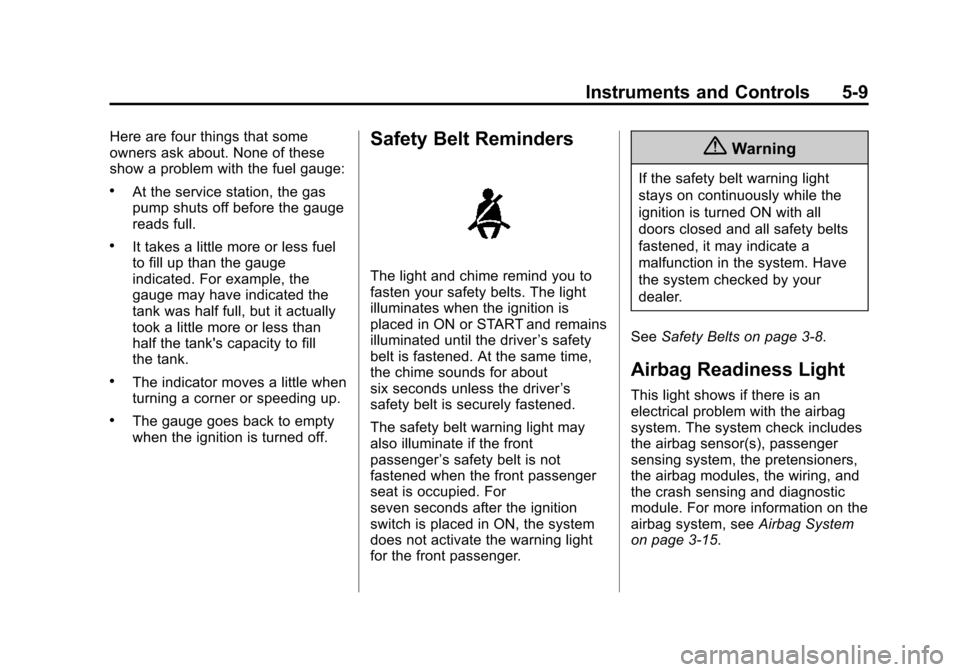
Black plate (9,1)Chevrolet City Express Owner Manual (GMNA-Localizing-U.S./Canada-
7707496) - 2015 - CRC - 11/26/14
Instruments and Controls 5-9
Here are four things that some
owners ask about. None of these
show a problem with the fuel gauge:
.At the service station, the gas
pump shuts off before the gauge
reads full.
.It takes a little more or less fuel
to fill up than the gauge
indicated. For example, the
gauge may have indicated the
tank was half full, but it actually
took a little more or less than
half the tank's capacity to fill
the tank.
.The indicator moves a little when
turning a corner or speeding up.
.The gauge goes back to empty
when the ignition is turned off.
Safety Belt Reminders
The light and chime remind you to
fasten your safety belts. The light
illuminates when the ignition is
placed in ON or START and remains
illuminated until the driver’s safety
belt is fastened. At the same time,
the chime sounds for about
six seconds unless the driver ’s
safety belt is securely fastened.
The safety belt warning light may
also illuminate if the front
passenger ’s safety belt is not
fastened when the front passenger
seat is occupied. For
seven seconds after the ignition
switch is placed in ON, the system
does not activate the warning light
for the front passenger.
{Warning
If the safety belt warning light
stays on continuously while the
ignition is turned ON with all
doors closed and all safety belts
fastened, it may indicate a
malfunction in the system. Have
the system checked by your
dealer.
See Safety Belts on page 3-8.
Airbag Readiness Light
This light shows if there is an
electrical problem with the airbag
system. The system check includes
the airbag sensor(s), passenger
sensing system, the pretensioners,
the airbag modules, the wiring, and
the crash sensing and diagnostic
module. For more information on the
airbag system, see Airbag System
on page 3-15.
Page 106 of 297
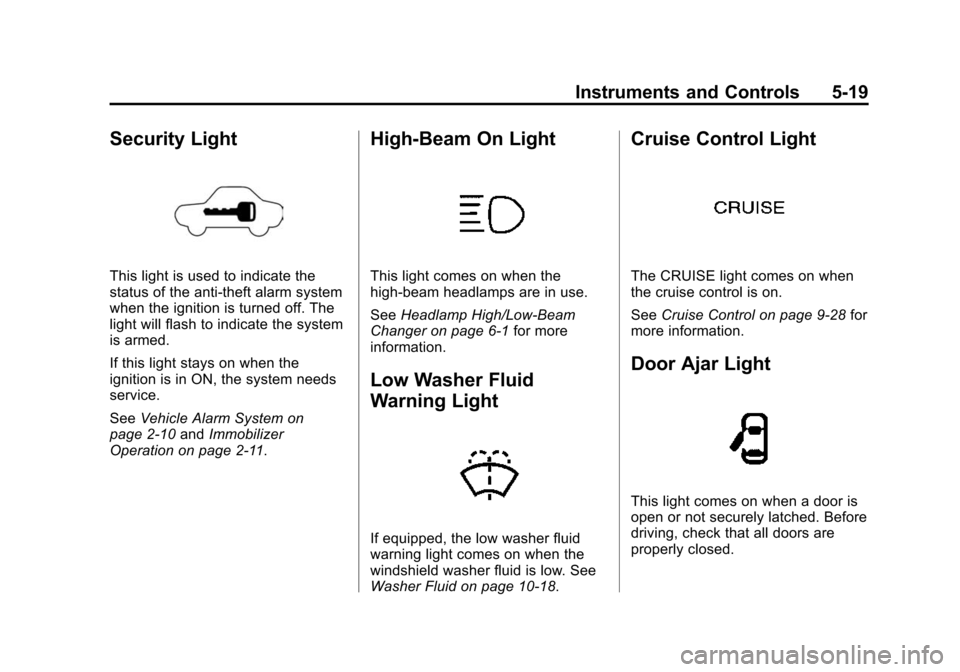
Black plate (19,1)Chevrolet City Express Owner Manual (GMNA-Localizing-U.S./Canada-
7707496) - 2015 - CRC - 11/26/14
Instruments and Controls 5-19
Security Light
This light is used to indicate the
status of the anti-theft alarm system
when the ignition is turned off. The
light will flash to indicate the system
is armed.
If this light stays on when the
ignition is in ON, the system needs
service.
SeeVehicle Alarm System on
page 2-10 andImmobilizer
Operation on page 2-11.
High-Beam On Light
This light comes on when the
high-beam headlamps are in use.
See Headlamp High/Low-Beam
Changer on page 6-1 for more
information.
Low Washer Fluid
Warning Light
If equipped, the low washer fluid
warning light comes on when the
windshield washer fluid is low. See
Washer Fluid on page 10-18.
Cruise Control Light
The CRUISE light comes on when
the cruise control is on.
See Cruise Control on page 9-28 for
more information.
Door Ajar Light
This light comes on when a door is
open or not securely latched. Before
driving, check that all doors are
properly closed.
Page 154 of 297
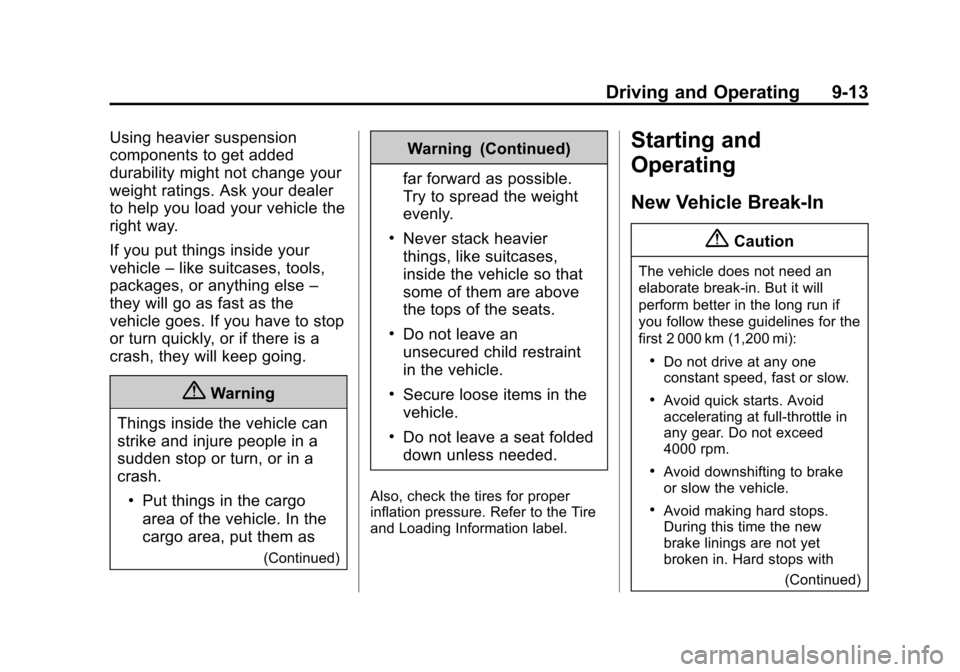
Black plate (13,1)Chevrolet City Express Owner Manual (GMNA-Localizing-U.S./Canada-
7707496) - 2015 - CRC - 11/26/14
Driving and Operating 9-13
Using heavier suspension
components to get added
durability might not change your
weight ratings. Ask your dealer
to help you load your vehicle the
right way.
If you put things inside your
vehicle–like suitcases, tools,
packages, or anything else –
they will go as fast as the
vehicle goes. If you have to stop
or turn quickly, or if there is a
crash, they will keep going.
{Warning
Things inside the vehicle can
strike and injure people in a
sudden stop or turn, or in a
crash.
.Put things in the cargo
area of the vehicle. In the
cargo area, put them as
(Continued)
Warning (Continued)
far forward as possible.
Try to spread the weight
evenly.
.Never stack heavier
things, like suitcases,
inside the vehicle so that
some of them are above
the tops of the seats.
.Do not leave an
unsecured child restraint
in the vehicle.
.Secure loose items in the
vehicle.
.Do not leave a seat folded
down unless needed.
Also, check the tires for proper
inflation pressure. Refer to the Tire
and Loading Information label.
Starting and
Operating
New Vehicle Break-In
{Caution
The vehicle does not need an
elaborate break-in. But it will
perform better in the long run if
you follow these guidelines for the
first 2 000 km (1,200 mi):
.Do not drive at any one
constant speed, fast or slow.
.Avoid quick starts. Avoid
accelerating at full-throttle in
any gear. Do not exceed
4000 rpm.
.Avoid downshifting to brake
or slow the vehicle.
.Avoid making hard stops.
During this time the new
brake linings are not yet
broken in. Hard stops with (Continued)